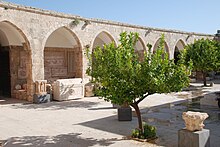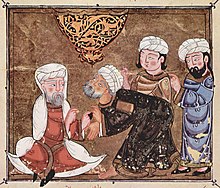Maarat an-Numan
|
معرة النعمان / Maʿarrat an-Nuʿmān Maarat an-Numan |
||
|---|---|---|
|
|
||
| Coordinates | 35 ° 39 ′ N , 36 ° 40 ′ E | |
| Basic data | ||
| Country | Syria | |
| Idlib | ||
| ISO 3166-2 | SY ID | |
| height | 530 m | |
| Residents | 90,861 (2010) | |
|
Eastern part of the city. The minaret near the end of the street locates the two khans.
|
||
Maarat an-Numan , also Maara , Marra , Maarrat , Maʿarrat al-Numān ( Arabic معرة النعمان, DMG Maʿarrat an-Nuʿmān ), is a market town in Idlib Governorate in western Syria , on the highway from Aleppo to Hama . The current name is a combination of the traditional name and the name of their first Islamic governor an-Numan ibn Bashir, a companion of the Prophet Mohammed .
Cityscape and history
The ancient settlement of Arra was captured by the Byzantines in the 5th century and conquered by Muslim Arabs in 637 . What followed was a prosperous trading center surrounded by gardens. The place was plundered several times, so in 968 by the Byzantines and in 1098 by the Crusaders . The Crusaders held the fortified settlement until it was retaken by Zengi in 1135 . It experienced a heyday with the Zengids from the 12th century. The minaret of the Friday Mosque , which was built on the site of an earlier basilica and was rebuilt after the earthquake of 1170, dates from this period . In 1932 there were 5250 inhabitants.
In the center of the busy trading town there are two khan ( caravanserais ) from Ottoman times opposite . The southern Khan can be seen from a distance next to the remaining old minaret, the rooms and the inner courtyard surrounded by an arcade are currently unused. The building complex of the opposite Khan of Murad Pasha from the 16th century includes a roughly square inner courtyard with a domed mosque in the center, together with a tekke (assembly room) and a hammam . A museum with mosaics from the " Dead Cities " (late Roman-early Byzantine settlements in the northern Syrian limestone massif) was set up in this Khan . In its wide vaulted halls it houses the largest collection of Byzantine floor mosaics in the country from the 4th to 7th centuries, which are supplemented by some well-preserved mosaics from Roman times.
The madrasa "Abu al-Farawis" from 1199 belongs to the city. The remains of the medieval citadel can be found on a hill in the northwest.
The Maarat an-Numan massacre
The well-known and terrible event happened at the end of 1098, during the First Crusade . It is related to the siege of Antioch , where the crusade army stayed from October 1097 to January 1099. At first the crusaders besieged the city of Antioch and were besieged after their conquest. Especially the winter of 1097/98 hit them completely unprepared, without sufficient food, clothing and accommodation. Initially, this mainly affected the simple crusade participants, but eventually also the knights, after incessant forays into the area no longer brought sufficient supplies. In the beginning donkeys and simple horses were killed for meat consumption, eventually also the valuable war horses and all kinds of small animals, including dogs. The chroniclers report that the soles of shoes were boiled. In addition, the simple crusade participants only had ragged robes and had no roof over their heads:
- The winter brought a severe shortage of food and also bitter cold ... The forage columns had to wander further and further into the area ... They unexpectedly came under the Damascus army ... Meanwhile the famine increased, the lower folk did not shrink from cannibalism . The so-called “Tafurs” stood out in particular, wild Flemings, always fighting in the forefront, who had come with Peter the Hermit and who were now enjoying fallen Turks.
The Franconian chronicler and contemporary Albert von Aachen reports:
- Not only did our people not shy away from eating killed Turks and Saracens, but they also ate dogs.
On one of these raids, the Crusaders reached the fortified city of Maarat an-Numan from their position in Al-Bara under the command of Raymond of Toulouse and Robert of Flanders on November 27, 1098 and began their siege. The city is located 10 kilometers east of Al-Bara as the crow flies and about 100 kilometers southeast of Antioch. After they had received reinforcements from Bohemond of Taranto , they stormed the city on December 12, 1098 and sacked it. The male residents were all slain, the women and children sold into slavery. The number of victims of this massacre is given in the sources as 22,000. Even if here - as is always the case in corresponding medieval sources - the numbers are greatly inflated, there can be no doubt that the number of victims was unusually high. On the other hand, this was by no means an isolated case on the First Crusade, as the cruelly bloody conquest of Jerusalem shows, about which even the Frankish chroniclers report with some horror. Albert von Aachen: "Pudet referre quod audierim, quodque dedicerim ab ipsos pudoris auctoribus." ("It is shameful to report what was heard and what is testified by the shame-filled chroniclers.")
cannibalism
However, it is not the fact of this massacre itself that made Maarat an-Numan notorious, but the circumstances surrounding it. Because when the city was sacked, little of the hoped-for food was found that could have averted the emergency:
- “While the princes were discussing Rugia, the army at Ma'arat en-Numan took action themselves. It was near starvation. All the food in the area had been used up; Cannibalism seemed the only way out. "
The Frankish chronicler and panegyrist Tankreds Raoul de Caen reports how the victims were dealt with:
- "Ours cooked the adult heathen in pots and put the children on skewers to devour them grilled."
Soon afterwards, in the year 1100, Archbishop Daimbert of Pisa , Gottfried von Bouillon and Raimund von Toulouse wrote (in Latin) to the Pope about these events :
| "A notre Saint Père le pape, à l'église romaine, à tous les évêques et à tous les chrétiens: | "To our Holy Father the Pope, to the Roman Church, to all bishops and to all Christians: | |
| [...] | [...] | |
| Nous fûmes bientôt livrés á une famine si cruelle, que quelques-uns de nôtres, dans leur désepoir, ne paraissaient pas éloignés de se nourir de chair humaine. Il serait trop long de faire le récit de tout ce que nous souffrîmes à ce sujet. | [About the siege of Antioch] We were soon subjected to such a cruel famine that some of ours, in desperation, seemed not far from subsisting on human flesh. It would take too long to give an account of how we have suffered from this cause. | |
| [...] | [...] | |
| Une famine horrible qui y assaillit l'armée, la mit dans la cruelle nécessité de se nourrir des cadavres de Sarrasins, déjà en putréfaction. " | [About the conquest of Ma'arat] A terrible famine that attacked our army made it necessary to feed on the corpses of the Saracens, which were already decaying. " |
The Frankish chronicler Petrus Tudebodus reports:
| “Nostri quoque pauperes peregrini coeperunt scindere corpora paganorum eò quod in ventibus eorum inveniebant reconditos bisantios; alii quoque districti fame caedebant carnes eorum per frusta et coquebant ad mandacandum. " | “The poor among our pilgrims had begun to dissect the bodies of the pagans to find the gold coins hidden in their stomachs; others, tormented by hunger, cut their meat into pieces and cooked it to eat. " |
aftermath
These events made a strong impression on the people of the Middle East . The crusaders received a reputation for particular cruelty and barbarism towards Muslims, Jews and even Orthodox (non-Catholic) Christians. Centuries after these events, their image as fanatical cannibals was still alive in Arabic literature, and the crusaders are still referred to as "cannibals" in many Middle Eastern countries. Some Arab authors suggest that the behavior of the Crusaders did not arise from hunger, but from their fanatical belief that the Muslims were even lower than the animals. The non-fiction author Amin Maalouf , Lebanese Christian, living in Paris and awarded the Prix Goncourt, writes:
- After his attack on Pope John Paul II in 1981, the Turkish assassin Mehmet Ali Agca declared that he wanted to "kill the Supreme Warlord of the Crusaders" - an admission that once again reveals the lasting trauma of the Crusades, even at a distance of almost a thousand years, left in the collective memory of the Muslim world. The bewilderment and horror of a highly civilized society in the face of the “barbaric invaders” from the West, who did not shy away from cannibalistic excesses, is reflected in almost all Arabic chronicles and reports from the period between 1096 and 1291.
In the Syrian Civil War
Maarat an-Numan was long held by opposition militias during the Syrian Civil War. In February 2016, the city's hospital was destroyed in an air strike, Doctors Without Borders reported . The organization had supported the clinic with 30 beds and 54 employees. MSF suspected either the Syrian government or Russia to be the originator of the attack. In mid-January 2020, Maarat an-Numan was considered to be the key position of the insurgents in defending the remaining rebel areas in Idlib governorate. In the course of an offensive, government troops had worked their way up to 7 km from the city by January 15.
On January 28, 2020, the remaining rebel fighters withdrew after government troops reached the city limits. The next day the Syrian government announced the capture of Maarat an-Numan.
sons and daughters of the town
- Abū l-ʿAlāʾ al-Maʿarrī (973-1057), poet and philosopher
- Basilio Khouri (1883–1941), Melkite Archbishop
See also
Web links
- Ma'arrat al-Nu'man. ArchNet Partly historical photos
- Source texts on the First Crusade
Notes and individual references
- ↑ Hans Eberhard Mayer : History of the Crusades , Stuttgart 2000 (9th edition), p. 52f.
- ^ Joseph François Michaud: Histoire de Croisades , Vol. 1, Paris 1825 (4th ed.), P. 373; Translation by user: Ulrich Waack
- ↑ Steven Runciman : History of the Crusades , Munich 1995 (dtv-TB 4670) ISBN 3-423-04670-8 , p. 249.
- ^ Joseph François Michaud: Histoire de Croisades , vol. 1, Paris 1825 (4th ed.), P. 641, has the Latin original ("ex manuscript Signiensis Monasterii") in French. translated; Translation into German User: Ulrich Waack
- ↑ JF Michaud: Bibliography des Croisades , Vol. 1, Paris 1822; Translation by user: Ulrich Waack
- ↑ Because the Crusades began soon after the Great Schism of 1054
- ↑ Archived copy ( memento of the original from February 15, 2016 in the Internet Archive ) Info: The archive link was inserted automatically and has not yet been checked. Please check the original and archive link according to the instructions and then remove this notice.
- ↑ Bombs destroy Syrian clinics - tagesschau.de on Feb. 15, 2016
- ↑ "Syrian airstrikes in Idlib leave at least 21 dead despite ceasefire" theguardian.com from January 16, 2020
- ↑ "Syrian army takes Maaret al-Numan after heavy bombardment" aljazeera.com of January 29, 2020




